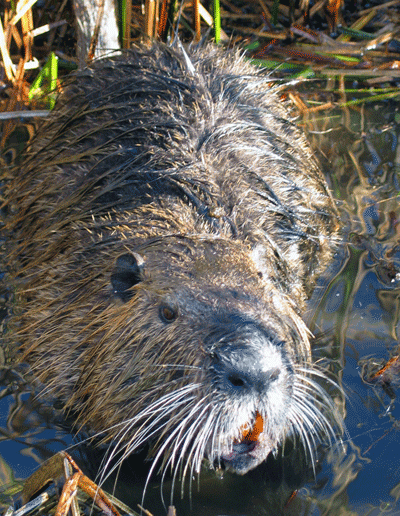
A nutria (Myocastor coypus). "Nutria are invasive, non-native, semi-aquatic, South American rodents first released into Dorchester County, Maryland in 1943." --U.S. Fish & Wildlife Service.
No one’s using the “E word” yet, but the virtual eradication of the Chesapeake Bay’s invasive nutria population — once considered improbable — should come by summer’s end.
The great marshes of Maryland’s Dorchester County, home to Blackwater National Wildlife Refuge, are considered cleared of the rat-tailed South American beaver.
Cleared too, are the infested rivers of the Delmarva Peninsula — Choptank, Nanticoke and Pocomoke. Nutria, once estimated at 50,000 or more and reported from the Chesapeake and Delaware Canal to Accomack County in Virginia, are down to a few hundred remaining animals.
In skiffs and in chest waders, employees of The Chesapeake Bay Nutria Eradication Project are bringing dogs, guns and traps to bear on marshes throughout a 15– 20-mile stretch of the Eastern Shore’s Wicomico River. It’s the final push, to be followed with a couple of years of monitoring.
On a chilly March morning, we nosed into a big cordgrass marsh a few miles south of Salisbury. Running the jon boat was Steve Kendrot, the U.S. Department of Agriculture wildlife management expert who has run the nutria project since 2002.
Spring is all about: ospreys back on their nests; redwing blackbirds staking out nesting territories; a loon arrowing overhead; eagles brooding their young in a tall pine.
Kendrot was focused elsewhere. “Turd,” he remarked, scooping from the creek an inch-long, banana-shaped object with fine grooves carved distinctively into one side.
It was followed by another, and another, carried on the outgoing tide draining the marsh. Soft and malleable—he handed it to me for scrutiny—“there’s no mistaking it for anything else.”
Two of the team’s professional trappers were already there, setting traps wherever little drains allow nutria to enter and exit the marsh. One trapper had built a mound of marsh mud at the confluence of two creeks, inviting nutria to haul out and rest.
In the center of the mound was a trap designed to close on the rodent’s foot, then drown it when it instinctively dove into the water. Bamboo sticks crossed above the trap would keep great blue herons from alighting there to fish.
Eradication of an invasive species is rare — usually successful on islands where it’s easier, Kendrot said. “It’s very different from management or control, and a lot more work.
“This marsh will take us two or three months. The first week we’ll get about half the nutria; three-quarters by the second week, 90 percent by the third. Then it’s just a slog, one stinkin’ nutria at a time, weeks and weeks, monitoring, looking for nutria hairs or scat, making sure re-invasion isn’t occurring.”
The numbers from the 12-year eradication effort reflect that, with the bulk coming in the early years. In all, the project has taken about 13,500 animals from across the more than 120,000 acres of the Bay’s wetland complexes.
That’s far less than some population estimates in the 1990s when nutria peaked. Back then, when I kayaked through Blackwater’s marshes, the wailing of nutria made sleep in one’s tent difficult.
Kendrot said it’s not uncommon for invasive species to boom, then settle back to a lower number. Cold winters take a toll because the animals haven’t evolved for the Chesapeake climate; and in the heart of their territory they had destroyed a lot of their prime habitat, chewing the roots that held the marsh together.
A surprise, he said, is that only 150 were taken from the Nanticoke River, which appears full of high quality habitat. “I expected thousands there,” he said.
Nutria were introduced as a potentially valuable furbearer in Louisiana in 1938. In that state’s extensive marshes and warmer climate, their numbers soared in the next 30 years from 20 animals to an astounding 20 million. Control efforts there take around 400,000 a year.
Nutria were imported widely, including to Dorchester County in 1943. Kendrot’s team has hosted delegations from South Korea and Israel, two of many nations trying to control nutria. Only England in the 1980s successfully eradicated them from marshes in East Anglia.
Factors from sea level rise to burgeoning resident geese and human development have destroyed marshes in the Bay region; but nutria damage was estimated at $4 million a year in lost ecological values. The eradication program costs about $1.4 million annually.
Kendrot is aware that two eradication efforts will culminate in Maryland soon. The state has reduced mute swans from thousands to dozens through shooting and preventing hatching by shaking or oiling eggs.
Lovers of the gorgeous swans fought that effort in court. The less lovely nutria has no defenders, although gaining permission to trap on private marshes has sometimes posed a challenge for Kendrot’s team.
He’s just beginning to think about his post-nutria career. At 43, he’s spent more than a quarter of his life on this eradication.


